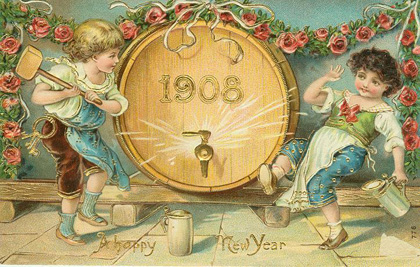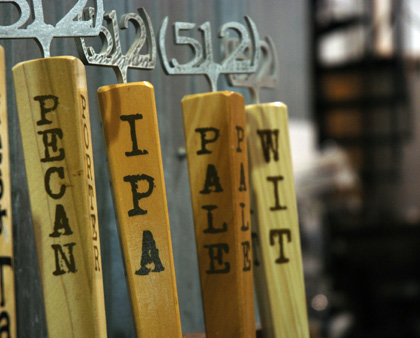
Additionally, “The findings are backed up by figures which demonstrate the local nature of beer around the world, with only 6% of global beer volumes drunk outside their market of origin.”

Additionally, “The findings are backed up by figures which demonstrate the local nature of beer around the world, with only 6% of global beer volumes drunk outside their market of origin.”
The story Adam has at beernews.org that Belgian brewery Duvel will produce Brewery Ommegang beers — otherwise made in Cooperstown, New York — may seem familiar. Duvel briefly brewed Ommegang beers five years ago when demand outstripped capacity.
Back then I took samples of Ommegang Abbey Ale brewed both in Belgium and New York to a local brewpub and asked customers there on a Sunday afternoon — most of whom, it turned out, had never tried anything from Belgium or even inspired by Belgian beers — if they could tell the difference. I repeated the experiment twice more, including with friends as interested in wine as beer, then hard-core beer savvy types who viewed the test as a challenge.
I’ve added the story that resulted to the library.
***SPOILER ALERT-SPOILER ALERT*** For those who don’t want to bother with the click the results are summarized below.
******
******
******
******
******
Quick summary of the results: Just over half (that’s chance) correctly picked out the odd beer in a “triangle tasting,” and 57 percent preferred the Cooperstown version.

You go first.

This not the official announcement for Session #49, because that will have to include broad definition of “regular” beer. Or not. But when The Session begins its fifth season in March each of the first three original hosts (that would be me, then Alan McLeod and Jay Brooks) will return to action in successive months. I can tell you right now that March 4 I’ll expect contributors to blog about a single “regular” beer.
For now when writing about “regular” beer: a) I’ll settle for Justice Potter Stewart’s “I know it when I see it” standard and b) I’m going to quit putting quotation marks around regular.
Brewery founder Kevin Brand includes pecans when brewing (512) Pecan Porter (d’oh). So maybe you’d rather put the beer in the innovative category — like others you need a Cuisinart to make. Not me. I’d drink this beer, available only in 15.5-gallon kegs, regularly if I lived somewhere I could buy it. Thus, a regular beer.
Pecan Porter was the first seasonal at (512), released in the fall of 2008 not all that long after the brewery opened. Brand knew he wanted to brew a dark, bold beer. Pecans made their way into the recipe because he saw construction workers hanging out under and eating pecans from a tree in the industrial park where (512) is located. Central Texas, of course, is thick with pecans. That’s why a new brewpub in Johnson City, west of Austin, is calling itself Pecan Street Brewing.
At first Brand and Nate Seale, who now does most of the brewing, roasted the pecans in their own ovens. Today Austinuts provides the roasted pecans, which Brand and Seale grind up in a Cuisinart (“My wife keeps asking when she’ll get it back,” Brand said) before tossing the mixture into the mash. Organic two-row, crystal, chocolate and black malts make up the rest of the grist and the wort is hopped with a single addition of Glacier.
The pecans add nutty, toasty flavors to the porter, with the black malt and restrained hops (30 bitterness units) nicely balancing crystal malt sweetness.
“It (pecan) is a deceiving flavor. People associate it with sweet, because usually it’s in something like pralines or pie, but it’s not,” Brand said. Pecan Porter was an immediate hit, both because of its flavors and because it has an extra bit of Texas in it. “Most of the people who support us are in love with Austin and in love with Texas,” he said.
So (512) made the porter — you guessed it — a regular beer.
Fine post at DesJardin Brewing centered on Jason Oliver, Devil Backbone Brewing and the excellent lagers Oliver brews there. Oliver gets a chance speak at length about why decoction (during which some of the mash is removed, boiled and returned to the original mash, often two or three times) matters. Good stuff, but I do wish he hadn’t said this:
What you can’t substitute is the romance of decoction! Even if you do not notice any difference in a beers taste, the fact you did one is not made any less valid. Craft brewing is a craft, and using a traditional method to brew a traditional beer is something to be celebrated not denigrated. My advice is if you can decoct it then do it on special brews, it makes it extra special, extra traditional, and extra authentic.
He and I talked a while back about how decoction adds flavor and texture to some beers. If you take the time to read “Decocting with Jason Oliver” you’ll notice not everybody agrees.
A few years ago Martin Krottenthaler, a professor at the Weihenstephan brewing university north of Munich, talked about research comparing decoction mashing and less-time consuming infusion mashing. He flipped through PowerPoint slides, explaining why lesser malts once made decoction necessary. “Boiling is boiling,” he said, showing benchmarks that the chemists recorded were different throughout the two processes but the resulting worts produced almost identical profiles.
Then he introduced the human element. A tasting panel basically confirmed the results, because few of its members could tell the difference — but Krottenthaler was one of those who could pick out the beers produced using decoction. “For me it was significant,” he said.
Krottenthaler’s experience is what decoctionist (yes, I just made that word up) should be talking about. I agree with Oliver that brewers make a statement about the artisanal aspect of their craft when they choose to use decoction. But it’s an empty gesture if the beer they create doesn’t actually taste better. It feels like we’ve stepped into the dreaded realm of marketing.
The reason to value traditional brewing methods is not simply that they are traditional but that they result in beers that tastes better. Try the ones from Devils Backbone and you’ll understand.
If that’s not enough for you, here’s a gem from page 27, where the author eloquently states the purpose of hops is to “…provide balance to the beer just as a girl’s left boob does for her right. One without the other is a freakish carny.”
And that’s the stuff you can print in a family blog.
Is the writer talking to you?